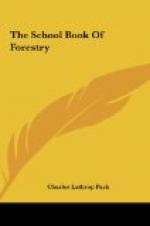Foresters try to locate and dispose of all the diseased trees in the State and Government forests. They strive to remove all the sources of tree disease from the woods. They can grow healthy trees if all disease germs are kept away from the timberlands. Some tree diseases have become established so strongly in forest regions that it is almost impossible to drive them out. For example, chestnut blight is a fungous disease that is killing many of our most valuable chestnut trees. The fungi of this disease worm their way through the holes in the bark of the trees, and spread around the trunk. Diseased patches or cankers form on the limbs or trunk of the tree. After the canker forms on the trunk, the tree soon dies. Chestnut blight has killed most of the chestnut trees in New York and Pennsylvania. It is now active in Virginia and West Virginia and is working its way down into North and South Carolina.
[Illustration: Section of A virgin forest]
Diseased trees are a menace to the forest. They rob the healthy trees of space, light and food. That is why it is necessary to remove them as soon as they are discovered. In the smaller and older forests of Europe, tree surgery and doctoring are practised widely. Wounds are treated and cured and the trees are pruned and sprayed at regular intervals. In our extensive woods such practices are too expensive. All the foresters can do is to cut down the sick trees in order to save the ones that are sound.
There is a big difference between tree damages caused by forest insects and those caused by forest fungi and mistletoe. The insects are always present in the forest. However, it is only occasionally that they concentrate and work great injury and damage in any one section. At rare intervals, some very destructive insects may centre their work in one district. They will kill a large number of trees in a short time. They continue their destruction until some natural agency puts them to flight. The fungi, on the other hand, develop slowly and work over long periods. Sudden outbreaks of fungous diseases are unusual.
Heavy snows, lightning and wind storms also lay low many of the tree giants of the forest. Heavy falls of snow may weigh down the young, tall trees to such an extent that they break. Lightning—it is worst in the hills and mountains of the western states—may strike and damage a number of trees in the same vicinity. If these trees are not killed outright, they are usually damaged so badly that forest insects and fungi complete their destruction.
Big trees are sometimes uprooted during forest storms so that they fall on younger trees and cripple and deform them. Winds benefit the forests in that they blow down old trees that are no longer of much use and provide space for younger and healthier trees to grow. Usually the trees that are blown down have shallow roots or else are situated in marshy, wet spots so that their root-hold in the soil is not secure. Trees that have been exposed to fire are often weakened and blown down easily.




